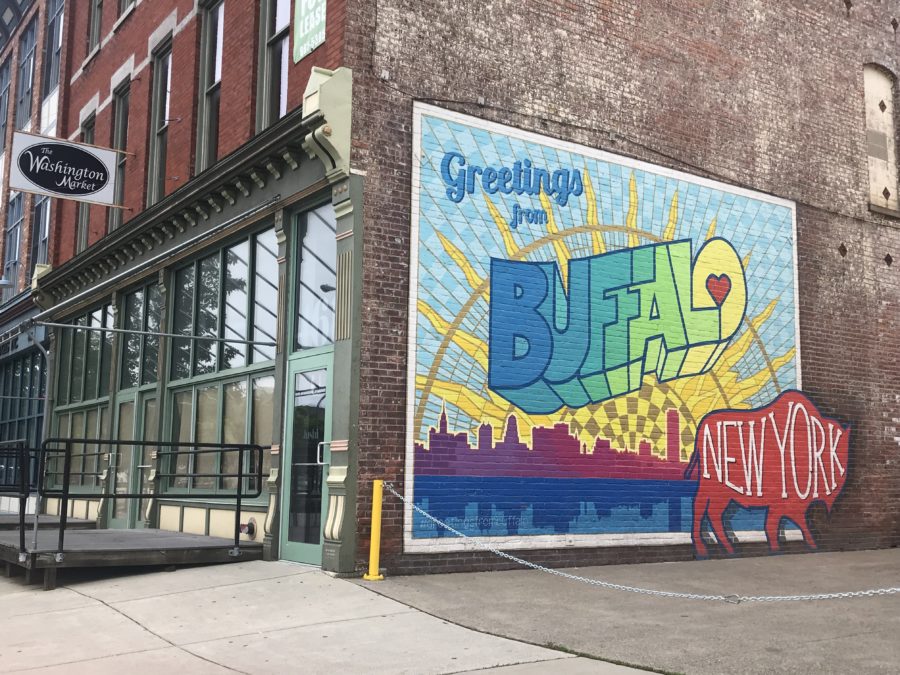
When I told people I was travelling to Buffalo, New York – a city which sits just off the Canadian border, a couple of hours from Toronto and next door to the Niagara Falls – I was meant with some level of skepticism. “Why are you going there?”, one friend asked me. Indeed, I had traveled through the place quite a few times over the years, but had never taken the time to take it all in. Much in part because so many had told me not to bother. And the reality is, for a long time, this was not without reason.
For more than a century, Buffalo was one of the most successful places in America, a booming Industrial town that saw a thriving community, and the sort of money that saw renowned architects like Frank Lloyd Wright design some of the city’s most illustrious homes, or the guy (Frederick Law Olmsted) who did Central Park to come and design their parks in the 1860s.
It all dates back to 1825, when the Erie Canal opened, connecting Hudson River to the heartland, the Buffalo River and Lake Erie. In more ways than one, the city became the gateway to the West, and it exploded. It was a quintessential boomtown of the time, with the Canal serving as a port for goods, spawning up a robust flour milling industry, before moving into steel and more.
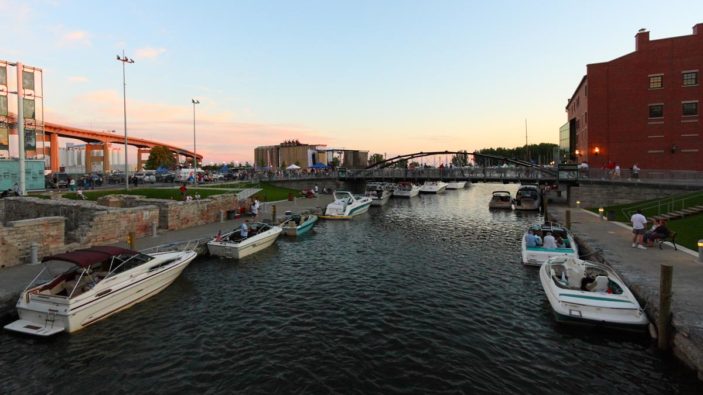
By 1982, the steel plants had closed, and the once prosperous community endured a serious downturn. It’s a story you find in pockets all over America – Detroit also being a city that comes to mind, though its damage being more relatively recent. And like Detroit, Buffalo has been enjoying a resurgence, thanks to low rent, long term redevelopment projects and creative minds that have helped breathe new light into the city.
But while Detroit’s resurgence as a destination for food and art lovers has been well documented, Buffalo’s evolution has been much quieter, largely due to the time it’s taken to bring the city back from the brink. But that in mind, when I pressed my friend, who was so concerned as to the reasons for my visit, as to why he felt that way, it quickly became apparent he hadn’t visited in more than a decade. And to say that place has changed in that time frame is an understatement.
Driving around on a Sunday afternoon earlier this year, the city was quiet, but there was so much to see. The architecture of the city is one to behold, with late 19th Century buildings, and early 20th Century standouts, including ones designed by Frank Lloyd Wright. Sadly many of these buildings had fallen into disrepute over the decades, and it’s taken years of restoration to bring the city back to its former glory.
Take Frank Lloyd Wright’s self described “opus”, the Martin House Complex – a 1 1/2 acre campus that was his biggest ever project, built between 1903 and 1905. It’s taken 25 years and 50 million dollars to restore the buildings and the landscape to how they were intended, thanks in part to having to reconstruct pieces that had been partially or fully demolished in the city’s rougher years. This has just finished, and the building is now open for public viewings, truly celebrating the city’s legacy from richer times.
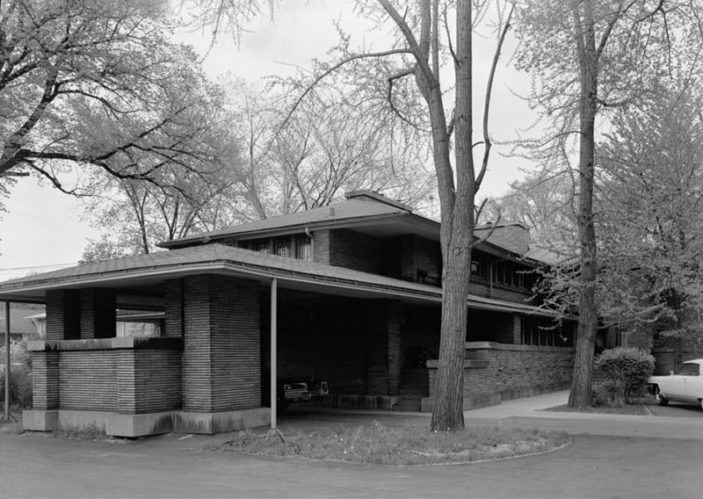
Along the waterfront – the Erie Basin Marina (which, fun fact, looks like a Buffalo when viewed from above) – you’ll now find some of the city’s most valuable property; but it wasn’t long ago that you would have avoided this part of town. The redevelopment of this precinct started back in the 80s, when the downturn was at its most apparent. And it’s a process that continues to this day. The outer harbour continues to be redeveloped, with lots of room to ride your bike, take your dog for a walk, and there’s even a new mountain biking course to enjoy.
Another area which is seeing new life is the Old First Ward, historically an old Irish neighbourhood. The Barrel Factory here is a 115 year old, restored old warehouse space that was empty for eons. Now it’s bringing new tourism to the area. There’s even plans nearby for a “High Line” inspired walking path; the New York City enterprise that has become the benchmark for revitalisation projects around the world.
And embracing the prosperous past also includes the Industrial aspects of the city, such as at Silo City, which sees an old grain facility being turned into a cultural centre, with the Torn Space Theatre, vertical tours of the grain elevators, restaurants, artist residencies and affordable housing still to come.
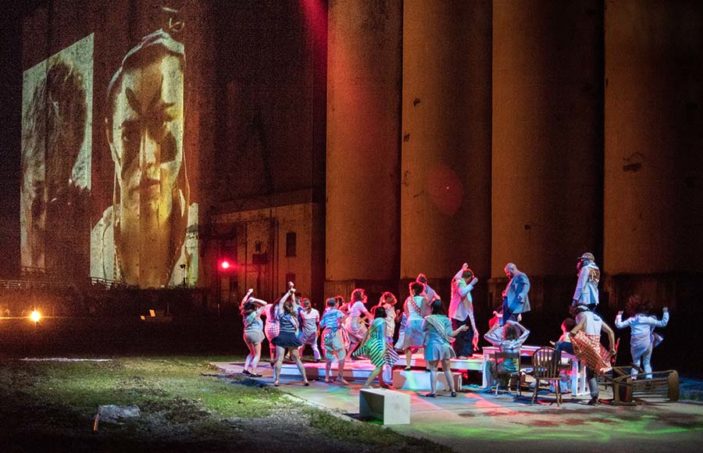
Then there’s Riverworks, which opened about four years ago, revitalising what was once a tyre recycling plant, and nearby grain elevators that you can now zip line between – which sits opposite a still functioning Archer Daniels Midland (ADM) grain plant. There’s also a General Mills plant where all the Cheerios in North America are made. The processes there – including delivery of grain by water – are remnants of that boom area. Beyond this, however, you’re going to discover a residential and recreational waterfront, rather than one of industry.
So aside from a couple of holdovers from the boom era, what is keeping Buffalo in business in 2019? Tourism and biotech are two of the biggest industries in the city, with the financial services sector creeping in behind. But music and arts can be seen everywhere, with beautiful street art taking over entire buildings, and venues like Nietzsche’s Bar, with the philosopher’s quote about live music on its side (“Life without music would be a mistake.”). Even Ani DiFranco is in the city, having bought a church and turned it into the Righteous Babe Records headquarters, with a great venue called Babeville inside.
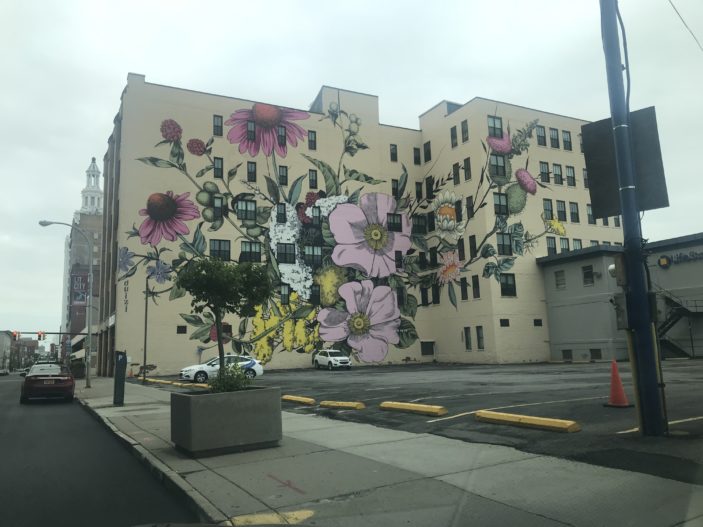
Public art is also exploding in Wilkeson Pointe, which opened 5 years ago or so. Here you’ll find a number of artworks from Robert Indiana, the guy who did the famed LOVE artwork in Philly. The works, now permanent, were originally installed for an exhibition retrospective at the incredible museum Albright Knox, which hosts a variety of concerts and other events throughout the year (including Death Cab for Cutie earlier this year).
Sadly, in November the Museum will close for restorations of its own for the next two years, however during that time they’ll be focusing on their public art projects. The beautiful flower mural you see above is just one part of their initiative. Elsewhere, you’ll find a brand new Children’s Museum, Explore & More, opposite the naval park at Canalside, and you can now check out The Spruce Goose at the Evergreen Aviation & Space Museum.
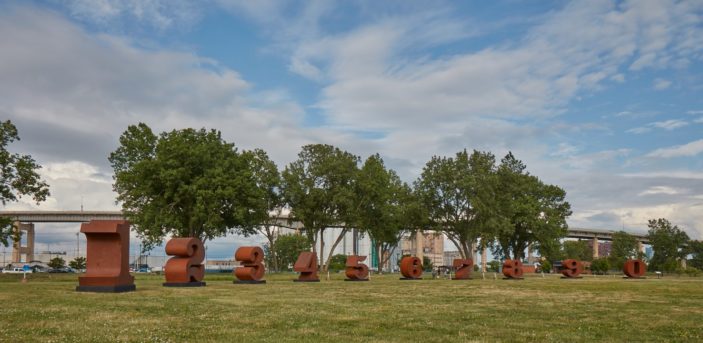
It’s clear that Buffalo is an ever evolving city, and it’s slowly working on getting locals, suburbanites and tourists to spread the word of just how much has changed here. Take the Garden Walk, for instance, an annual event that happens at the end of July, in the Park Meadow and Parkside neighborhoods. It’s the largest Garden Walk in the United States, and celebrated its 25th anniversary this year, bringing in some 60k people. The gardens in question are those sitting outside some of the city’s most beautiful buildings, and was designed as a way to celebrate the beauty of the area, help change the image of the city (as much for local residents as anyone else) and raise the value of the area.
In the end, the hope is that rather than hearing “Why are you going there?”, you’ll be asked “When are you going there?” the next time you ask your friend about a trip to the North West of New York State.
Where to Eat in Buffalo
There’s fantastic food to enjoy all over the city. Spend some time in Larkin Square, and scope out the Swan Street Diner, a quaint old diner notable near its centre. While in town, I also had a great meal The Dapper Goose. You may have also heard of the Buffalo Wing, and indeed this is where it was invented. The home of the wing is the Anchor Bar, where it debuted in 1964. It’s now the heart of what’s called the Buffalo Wing Trail, with 12 spots that are considered the best places for the wings in the city. You won’t have to go far, too, to find a food truck – and you can explore a lot of the best places in town via a Streetcar that runs the 10.3 km from the Waterfront to the University.

Getting to Buffalo
Buffalo has its own airport, which also serves as the entry point for the Niagara region. It’s a popular destination not just for travellers looking to come to Buffalo or Niagara, but also Toronto – as flights are usually cheaper, and it’s only a two hour drive from the Canadian city. It’s a small airport, so getting in and out happens with a breeze, and if you’re hungry you’ll even find an Anchor Bar serving up Buffalo Wings. Though there’s always a Tim Horton’s (a Canadian coffee staple) for those in more of a rush. I’ve enjoyed a wrap and a hot drink from them more times I can count.
Where To Stay in Buffalo
With new tourism coming into the city, comes new hotel options. One of the newest is an Aloft Hotel, attached to the historic Buffalo Christian Center. They’re still building some attractions here, and you’ll already find a pool and a fitness centre here, and a bowling alley will open next year. And with youth ice hockey such a passion here, the new Marriott Hotel even has its own rink – which is sitting next to the Keybank Centre, where the Ice Hockey games are played by the local team the Buffalo Sabres.
While we were in town, however, we stayed at Hotel Henry Urban Resort, a popular wedding destination with 88 rooms that opened about 3 years ago. Due to weddings and other events, it’s hard to get a room here on the weekends – but if you can it’s a must. It sits inside the walls of an former insane asylum, with some of the highest ceilings and longest curtains you’ve ever seen. And all held up by stunning pylons that sit as something of a centrepiece in your room, next to what is a delightfully comfortable bed.
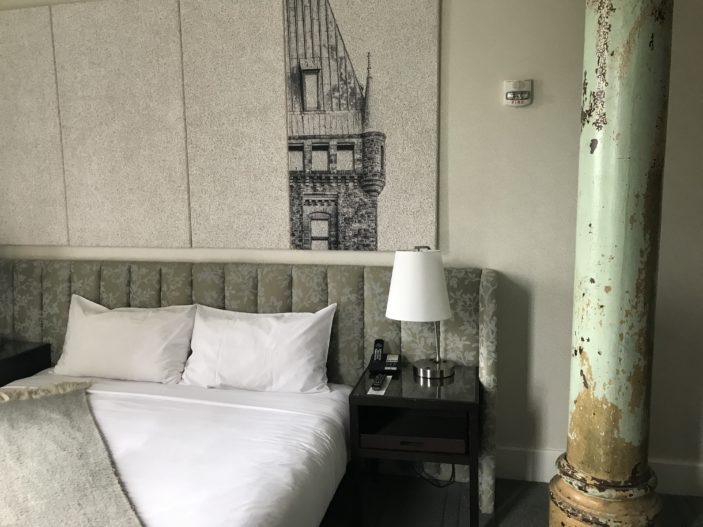
There’s some true luxury to be found here, inside true architectural splendour. Honestly it’s worth a visit just to see the building alone, which was originally built in 1870, and was in use for a century.
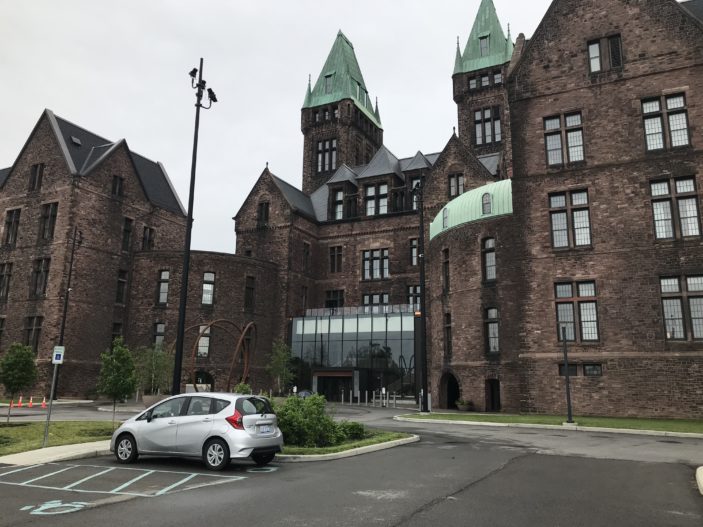
The author visited Buffalo with the support of Visit Buffalo Niagara, and stayed at Hotel Henry as a guest of the hotel for one night. Head HERE to book at night at the hotel. Photos by the author unless otherwise mentioned.
